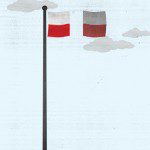Lost and Bound
Now that literary journalism is all but gone from magazines, many writers are choosing to walk a perilous tightrope to books. Good luck with that
Andrew Westoll was on a mission. His motorboat, loaded with food and supplies, pushed upriver. Along the banks of the Sipaliwini River the foliage was dense, the layers of varying shades of greens and browns occasionally reverberating with bird cries. He was deep in the neotropical jungle of southern Suriname, the least-travelled country in South America. But as he and his crew wound their way up the river, his mind was on something even more rare.
Westoll was searching for the okopipi, an unusual frog species known for the potency of its poison and its blue colour. Once traded on the exotic species market, the okopipi is now endangered. During his four-day journey to the home of these frogs, Westoll realized that he had the makings of a non-fiction book.
After glimpsing the elusive amphibian, Westoll’s initial search was complete. Still, another had just begun. While on that river in the remote jungle he had evolved from a freelance journalist into a non-fiction author. He’d now have to embark on the mission of writing his book and getting it published.
Westoll is far from alone; the worlds of journalism and publishing have long collided in Canada. But his quest to make a career out of writing books would prove as rewarding and perilous as his adventures in the rainforest.
With fewer and fewer publications in this country willing or able to publish literary journalism, more and more writers are turning to nonfiction books. But the magazine and book-publishing industries are two separate businesses with different editorial standards and expectations of success. The apparent freedom of writing books comes with new challenges. And certain stories can end up homeless, unable to find a place in magazines or books, which is bad for writers and their readers.
From the late 1960s to the mid-1990s, literary journalism flourished in this country. Saturday Night published stories as long as 10,000 words, and Toronto Life, Chatelaine, Maclean’s and others ran pieces that were 5,000 words or more. Today, the space for feature writing is shrinking. Fewer publications are willing to run long-form writing, and when they do, the pieces have much lower word counts than 20 years ago. While 6,000- and 7,000-word stories still appear, they are the exception rather than the norm. So the non-fictionbook is increasingly the dominant place for this type of journalism.
However, as Westoll discovered when he returned from the jungle, a book contract does not mean financial security. His book, The Riverbones: Stumbling After Eden in the Jungles of Suriname, garnered good reviewswhen it came out in 2008, but he’d been able to translate his Suriname adventures into prose only by living rent-free at his sister’s condo for four months and cobbling together an income by writing for explore, The Walrus and The Globe and Mail. Westoll describes the space for long form in Canada as small. “It’s always been a pretty narrow landscape, and from what I see,it’s probably shrinking,” he says. “I don’t think you’ll find anyone who says it’s not really tough right now.”
As Westoll discovered, unless a writer is well established, it is virtually impossible to earn a living writing books only; advances are insubstantial,usually between $20,000 and $40,000. And writers generally get a third of their advance up front, another third when they hand in the first draft and the rest on publication. Even if the advance is sizable, when divided into chunks it means journalists live in poverty unless they are able tosupplement this income. “The only reason I am able to spend two years of my life right now writing this one book and focusing solely on it is because I sold the book in the U.S.,” says Westoll of his current book, abouta family of chimpanzees in an animal sanctuary outside Montreal. “I made enough money to stop freelancing and focus solely on the book. But I didn’t go out and buy a mansion.”
Certainly, few writers begin a non-fiction book with expectations of a big payday. Richard Poplak trained as a filmmaker but switched to freelance journalism in 2005 and since then has written three books.“You have to readjust what it is you think middle-class life should be if you want to be a professional writer,” says Poplak, whose South African origins are evident in his speech. “It’s not going to be about $75,000 every year, year in and year out.” He’s written for This Magazine and Toronto Life, but acknowledges that at a national level “the only game in town really is The Walrus.”
Books afford him more control over his work: he doesn’t have to take on as many pieces he dislikes and isn’t forced to constantly pitch stories. He is careful to note, though, that writing books definitely has disadvantages. “They are just not lucrative. They take up a lot of energy, they suck a lot of time, they half-kill you. And then there is the publicity.” He pauses before continuing and fingers the stubble on his jaw. “At the same time, they increase my brain—they’re very exciting projects. When you are working on a journalism book on a topic you’re in love with, there is just no greater thrill in the world, and that’s worth a lot of money for me.”
Money does matter, though, and writing non-fiction in this country is a very different experience from in the United States. The American market is huge in comparison so there are more publishing houses and more money for advances. “A book that could command a healthy advance of 20 grand in Canada will command three or four times that,” says Westoll. But American publishing houses are more interested in American writers than authors from north of the border. Most journalists in this country who choose to write non-fiction books will be published first here and earn a Canadian advance. “If you want to do interesting stuff, you need to have a backup skill set that you can make money with,” says Poplak. And this is exactly what most non-fiction authors do: make their money elsewhere. Journalists who write books also frequently teach, freelance for newspapers and magazines or have full-time jobs.
Katherine Ashenburg agrees that writing a non-fiction book is an act of love. A CBC Radio producer before becoming the editor of the Globe’s arts and books sections in 1989, she remained at the paper for a decade, during which time she wrote a book on the architecture of southern Ontario towns. But Ashenburg quit the job to write about the rituals of mourning. While she had found it possible to write her architecture book whenever she had spare time, she couldn’t do the in-depth look at grieving practices required for her second book in the evenings and on weekends. Then the publication of her third book changed her perspective on what she was willing to undertake. “I don’t ever want to write another long non-fiction book that takes me four years to research and write.”
That book was an examination of the history of cleanliness. The Dirt on Clean was a literary success that proved to be a money-losing proposition for its author. Ashenburg received $40,000 from Knopf as an advance, a good sum by Canadian standards. However, the costs of writing and research piled up. Frustrated when she realized that she’d lost hundreds of thousands of dollars in the four years it took to write Dirt, she tallied up her expenses and produced something truly rare: a detailed summary of how much it costs an author to write a book. At a Banff Literary Journalism lecture in 2008, Ashenburg took the audience through all the numbers, from advances to travel expenses to translation services and trips to New York City to meet her publishers. She then compared the years of research and writing to her income at the Globe. “I made $269,000 less,” says Ashenburg, whose salary at the paper had been $90,000 a year. “It cost me $269,000 to write the book, and this was a book that was sold in 12 countries and won prizes. Except financially, it was a very successful book—it got wonderful reviews, tons of publicity.” She cites a 2008 Quill &Quire survey that put the annual salary of a typical senior editor at a major publishing house at $46,000, more money than Ashenburg’s advance, which had to last four years. “I’m really glad I wrote Dirt on Clean and The Mourner’s Dance,” she says. “But I did that and I don’t want to do it again.”
Yet Philip Marchand, a book columnist at the Toronto Star for 19 years, understands the pull. “There is nothing like the challenge of a book,” says Marchand, who has written five. “If it does break through, if it becomes one of those works that, for whatever reason, people start to talk about and it becomes a bestseller or even if it just creates a stir, then you feel you’ve done something.”
Researching and writing a long piece of literary journalism may take weeks or months, but writing a book often takes years. A subject that once seemed promising and compelling has ample time to reveal plenty of snags or even prove fruitless. “If a magazine article doesn’t work out, you get, if you’re lucky, a kill fee and hopefully you wouldn’t have done too much work on it,” says Marchand. “But what happens if you’re two-thirds of the way through a book and the key source has not yet opened up to you? It’s sleepless nights.”
Still, he says writing a book can be a smart decision. He wrote one about Marshall McLuhan in the late 1980s, when he was feeling dissatisfied with magazines and sought wider recognition for his work. “You can have a hundred magazine articles, a thousand magazine articles, to your credit, people still don’t know who you are because they almost always don’t notice the byline,” he says. “You build up a reputation in the business, but for the most part people don’t know who you are.” While acknowledging that if he broke down his earnings for the McLuhan project into an hourly wage, he would have been making a pittance, he points to the long-term benefits. “The book changed my life. I don’t think I would have gotten the job at the Star if I hadn’t done it because it gave me intellectual literary credentials in addition to my journalistic background,” he says. “It really was important for me and I’m still getting the benefit. I can’t overestimate the fact that that book emotionally, intellectually and ultimately financially is something that made me feel like a substantial writer.”
Anne Collins’s spacious office is like a menagerie, only the animals are books. There are so many of them: they line the walls in bookshelves and sit piled on top of cabinets. Beside her laptop on her wide, wooden desk are jars of pencils and pens and an old-fashioned Rolodex; a small carved stone elephant sits off to one side.
Like Marchand, Collins has straddled the worlds of magazines and books. She came to Random House of Canada in 1998, where she is now the vice president, after 20 years as an editor and freelancer for magazines. She also wrote two non-fiction books. Having seen many different sides of literary journalism, she’s blunt in her assessment of the current state of long-form: “There just aren’t very many places to practise it.” But she doesn’t see books as a viable medium to fill the void left by a shrinking periodical market. “You just can’t transfer what used to be done in magazines into book form and think we’re going to have a wonderful culture in which people get to know what they need to know. If I did a hard-hitting investigative piece that was published in Toronto Life, I knew that it would go out to 100,000 people; if I did the same thing in book form, a wild non-fiction bestseller in Canada sells about 30,000 in hardcover.”
In addition, the book and magazine industries get their revenues in very different ways. “With magazines,” she says, “your money doesn’t come from the actual thing itself; it comes from selling ads.” Because these publications do not have to worry about pleasing every reader, they have the freedom to tackle difficult and controversial material and take on subjects that haven’t been written about before. Magazines can afford to take more risks because buyers will pick up an issue for one or two stories, but with books, readers have to be interested in that one topic. “When you’re doing long-form journalism in book form,” says Collins, “people have to want to pay money for them or they won’t exist. There are some stories that really need the canvas of a book in order to get them told, but that doesn’t necessarily mean that anybody will buy them.”
Increasingly, authors and publishing houses are finding that their choice of retailers to buy these books is also limited. Independent bookshops are often responsible for fostering lesser-known authors, and they’ve been closing at an alarming rate. Don Sedgwick, president of Transatlantic Literary Agency, says there are now fewer mid-list books because there are fewer small bookstores, and big chains no longer devote as much shelf space to books unlikely to become bestsellers. There are also fewer opportunities to promote books or even get reviews in newspapers. The Globe, for example, killed its stand-alone book section in 2009. “Now, with this concentration on bestsellers and a diminished media, it means that publishers and booksellers are taking fewer chances on authors that are unproven, so you are not getting those middle-selling books anymore,” says Sedgwick. “It has almost become an all-or-nothing show out there.”
Additionally, not all feature ideas, or finished features, translate into viable non-fiction books. Some stories that could have made good magazine pieces won’t be published because they don’t work as books. “There are all kinds of subjects in this country that never get in magazines because we have one national magazine and that’s it,” says Ashenburg. “I’m sure there are all kinds of stories that never get told.” And some authors will write a book even when it’s not the ideal format for that particular subject matter. As a member of the 2010 jury for British Columbia’s National Award for Canadian Non-Fiction, at $40,000, it’s the largest prize in the country for non-fiction, Marchand read roughly 150 books. “You think, why did the publisher decide to do this?” he says. “Why are these books published? About half shouldn’t have been books.”
The business side of publishing also determines whether an editor can buy a book. “You can’t do a book only because it is important,” says Collins. “You can only do it if it’s important and people will want to read it, want to know about it.” On top of the bookshelf across from her desk, she has three 2004 books propped up so their covers are on display: The Trouble with Islam, by Irshad Manji, Shake Hands with the Devil, by Roméo Dallaire and The Story of Jane Doe, by Jane Doe. While Manji’s and Dallaire’s works did well, Doe’s didn’t sell, despite winning several awards. Collins walks over to the bookshelf, reaches up and adjusts its jacket. “It was an important book. That’s why we did it,” she says. “But not many people want to read about rape.”
Far from the jungles of Suriname, Andrew Westoll is working on his second book. “I’m not down on the non-fiction book idea at all,” he says. “Long-form journalism is a tough thing to pull off as a sustainable career, but if you couple that with books, I think it’s doable.” Practising literary journalism as a career has never been easy; however, books, despite all the challenges they present, will still come out because people who truly want to write long will continue to do so. “The thing about books,” says Collins, “is that, even more than long-form feature journalism, they come out of the passion of the writer.”
This is a joint byline for the Ryerson Review of Journalism. All content is produced by students in their final year of the graduate or undergraduate program at the Ryerson School of Journalism.












































